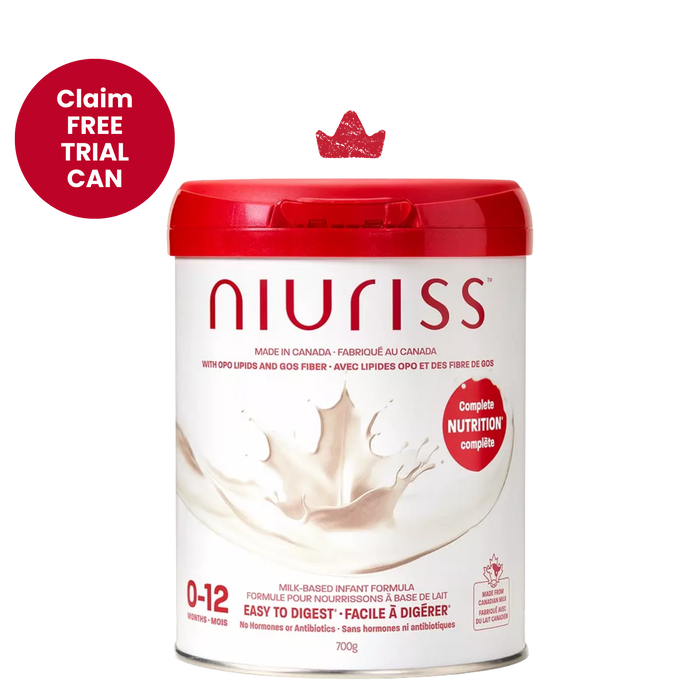

Baby Hunger & Fullness Cues in Feeding | Niuriss Canada
Written by Leena Tabaja. Customer Service Coordinator
& proud mom of two.
As a first-time mom, navigating the world of feeding your newborn can be both exciting and overwhelming. Even for experienced moms, each baby comes with their unique set of challenges, feeding preferences, and routines. Understanding when your baby is hungry and when they are satisfied is a crucial aspect of parenting, but it can often feel like deciphering a mysterious language, especially when your newborn seems constantly hungry! Did you know how much a baby’s stomach grows in the first few weeks of life? Have you considered how much this would affect their feeding habits? A newborn baby’s stomach is just the size of a cherry but undergoes rapid expansion, doubling in size within the first week and reaching the size of a large egg by one month! Your growing infant will need more calories and will require significant adjustments in feeding routines. Your infant’s stomach will grow quickly to accommodate more volume and it’s no surprise your infant’s feedings needs will increase. The growth rate of your child over the first few years of his or her life will be unmatched for the rest of their lifetime and can be influenced not only by nutrition, but also by genetics, medical conditions and your child’s socioeconomic environment.

What is cluster feeding?
Cluster feeding refers to a pattern of feeding behaviour in infants and is particularly common in the first few months of life. Your infant may feed more frequently than usual during certain periods of the day. These feeding sessions may be shorter than normal due to their higher frequency and may be accompanied by infant fussiness, need for soothing and comfort and often coincide with growth spurts. It can be a sign your infant is entering a more rapid growth phase and thus needs more nutrition. This feeding pattern may continue for up to 3-4 months. Ensure you follow your baby’s hunger cues so they remain satisfied during this period, while also being mindful of their satiety and need for rest.
You can rest assured that this is a normal phase of infant development and it will provide a unique opportunity for bonding between you and your child. It will also likely help facilitate an increased milk supply if you are breastfeeding. It is safe to feed your baby as you normally would during this period, be that from your breast or with infant formula. If you have concerns about your infant’s feeding cues or need assistance during this period, consider consulting your pediatrician or a lactation consultant.

How can I tell when my baby is hungry?
Babies communicate their hunger in different ways. It is important to recognize common infant hunger cues so you can respond to your child’s needs promptly and ensure feeding times are more efficient and less stressful. Here are some hunger cues to look for to know when to feed your baby:
- Rooting reflex: Your baby may turn their head towards your hand or chest and open their mouth. Your baby may even stick their tongue out when you touch their cheek.
- Sucking motions: your baby may suck on their hands, fingers, or clothing, looking for something to feed. This can sometimes be accompanied by lip smacking.
- Increased alertness: your baby may become more alert and active when they are hungry. They may wriggle or become restless, show increased eye movements or clench their fists.
- Fussiness or crying: crying may be a late sign of hunger, so it’s best to try feeding before your baby gets fussy.

How can I tell when my baby is full?
Just like hunger cues, your baby will show signs of satiation as well. These are important signs to recognize to ensure your baby is not overfed and to help them develop healthy eating patterns. Common fullness cues include:
- Slowing down or stopping suckling: your baby may slow down suckling or stop altogether when they are satisfied.
- Turning away/Losing Interest: when your baby has had enough to feed, they may turn their heads away from the bottle or breast.
- Relaxed body language: your baby will appear more relaxed and content after feeding.
- Falling asleep: during a feed, when your baby is full and satisfied, they may fall asleep in your arms, a serene reminder of the comforting connection shared between parent and child
Make sure you allow your infant to set the pace of feeding. Don’t try to make them finish a bottle or stay on the breast if they are showing signs of being full.

Diaper patterns are important indicators of adequate nutrition and a functioning gastrointestinal tract. This includes the frequency and volume of urination, as well as the frequency, colour, smell and consistency of bowel movements. A typical healthy baby will have wet diapers regularly, indicating good hydration and normal development. In the first week, passing soft stools 1-2 times/day or more is common. If your child is growing and reaching appropriate milestones according to standardized growth charts, along with a visibly normal bowel and bladder pattern for their age, they are likely receiving adequate nutrition.

General Feeding Guidelines
It may be hard to figure out your baby’s feeding patterns right away, so having a general feeding guideline is always helpful. While each baby is different, the following chart can provide a useful starting point as you familiarize yourself with and respond to your baby's distinct nutritional requirements. Learn more with our feeding guide.
It is important to follow the guidelines on your infant formula can for reconstitution instructions. This ensures the formula’s nutritional content is sufficient for a given volume. For Niuriss Stage 1, add 1 scoop of formula to 30ml of distilled or sterilized water. Ensure that water is lukewarm or room temperature before giving to your baby.

Go With Confidence
It's essential to pay attention to your baby's cues and respond promptly to their hunger and satiation signals. Every baby is different, so it may take some time to learn your baby's individual cues and feeding patterns.
If you choose to formula feed your baby or use formula as a supplement to breast milk, be assured that you can always trust Niuriss to provide complete nutritional support for your growing infant needs. With our carefully crafted infant formula, we are here to ensure that your baby's nutritional needs are met with care and reliability.

Leena Tabaja
Customer Service Coordinator
& proud mom of two




